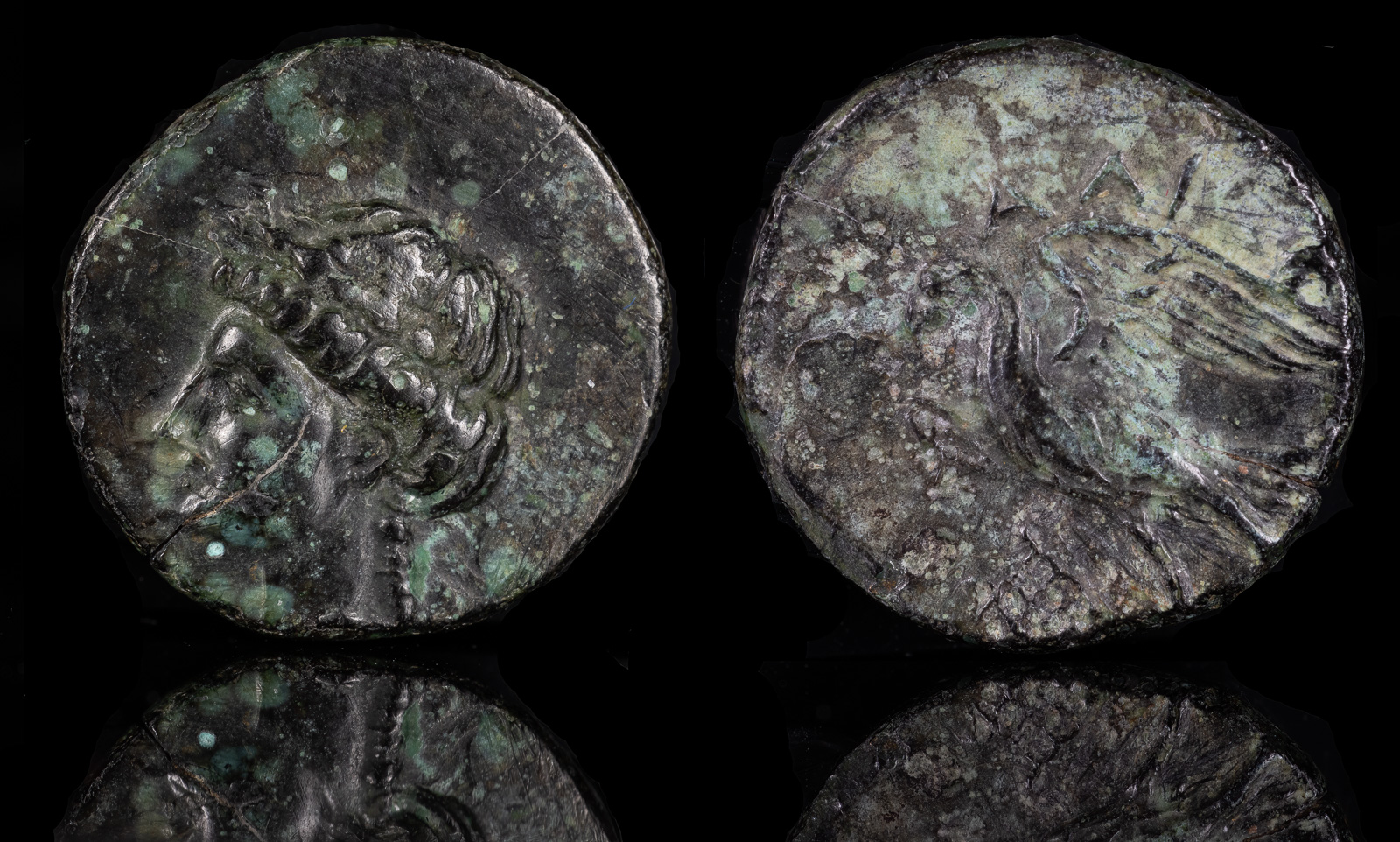
CARIA. Halikarnassos
Mid 4th-3rd centuries BCE
Chalkous AE 12 mm, 1.04 g, 12 h
Laureate head of Apollo to left. Rev. AΛI Eagle standing left; to left, lyre.
BMC 18. Karl 133-137. SNG Copenhagen 346-7. SNG Keckman 50
Ex J. Metzger Collection
Halikarnassos was most famous for having one of the Ancient Seven Wonders of the World in the Mausoleum of Halikarnassos. This was named for the king Mausolus, whose tomb it was.
Very little remains today of the Mausoleum, though we do have its base – which is more than we have of several of the other Wonders. Of the six that have been destroyed (the Pyramids are still around), it was the last to go during a series of earthquakes in the late Middle Ages. We do still have some of its artwork in various museums.
The succession of satraps who ruled Halikarnassos before and when Alexander the Great arrived is complex. Mausolos ruled until 353 BCE, when his sister Artemisia II took over. She lasted all of two years before dying according to Cicero of grief but more likely due to something else.
Idreos then became satrap, and he finished the Mausoleum. He died in 344 BCE and his sister Ada, who was also his wife, took over. Yet in 340 BCE she was usurped by her brother Pixodaros. Interestingly, Mausolos, Idreos, and Pixodaros all minted coins, but neither Artemisia II nor Ada did.
Pixodaros played a factor in Alexander the Great’s progression when he attempted to secure a marriage between and Alexander’s stepbrother Philip Arrhidaios. Alexander, who worried that such a union would threaten his standing as the heir to the throne, proposed himself as the groom instead. Pixodaros was more than happy for the upgrade, but Philip II was furious and the resulting argument led to Alexander fleeing to Illyria with several of his closest friends.
Pixodaros died in 335 BCE, and Orontobates, who was not in the dynastic line, was appointed satrap by Darius III.
When Alexander arrived, Orontabates, supported by Memnon of Rhodes, resisted him. This resulted in the great Siege of Halikarnassos where Memnon and Alexander faced off directly for the only time. Memnon proved more than a match and frustrated the Macedonians for some time. Just when Alexander’s army seemed on the brink of defeat, they breached the city walls. Memnon then burned the city and evacuated his troops.
Alexander did a thorough job of destroying the city, then gave the satrapy back to Ada, who had surrendered her fortress and even ‘adopted’ him as her own son. This wise move assured that she was in his favor and her rewarded her handsomely for it.
Most of the city was never rebuilt after Alexander’s destruction and can more or less be seen as it was demolished. Today it’s a major tourist attraction.
According to Athenaios, sea-water was used in the production of their wines.
The historian Herodotus is born in Halikarnassos.
Five ships from Nisyros accompany Artemisia of Halikarnassos, but they defect to the Greek side.
September 26
Aegina plays a significant role in the Greek naval victory against the Persian Empire in the Battle of Salamis. Byblos, Arados, Tyre, Halikarnassos under Artemisia, Kos, and Sidon support Darius. Chalkis and Kythnos support the Greek effort. Alexander I serves as a peace negotiator on behalf of the Persians.
The tyrant Lygdamis II puts to death the poet Panyasis, which causes the historian Herodotus to leave Halikarnassos.
Hekatomnos becomes king of Caria, then including Halikarnassos, under the Persian Empire.
Mausolos moves the capital of the Hekatomnid Satrapy from Mylasa to Halikarnassos.
Phaselis concludes a treaty with Mausolos of Halikarnassos.
350 BCE
Construction of the Mausoleum of Halikarnassos, one of the Seven Wonders of the World.
Death of Mausolos at Halikarnassos and reign of his sister Artemisia II.
Death of Artemisia II at Halikarnassos and reign of her brother Idreios.
Death of Idreios at Halikarnassos and reign of his wife and sister Ada.
Ada is usurped by her brother Pixodaros in Halikarnassos.
Alexander the Great besieges and eventually takes Halikarnassos, which is strongly defended by Memnon of Rhodes.